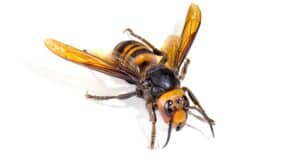Wasps are insects that belong to the Hymenoptera phylum with over 75,000 species. Since many wasp species, especially yellowjackets, feature yellow and black markings, bees are sometimes mistaken for wasps. Although yellowjackets derive their common name from how they look, certain subspecies have a variety of colors. This insect species’ most vividly colored individuals are stinging wasps belonging to the Vespidae family, which also come in brown, metallic blue, and bright red varieties. One of the more widespread species in North America, paper wasps resemble yellowjackets and hornets and are typically brown in appearance.
As Texas is a massive region in the United States with varied seasons and topography, diverse wildlife is no surprise. You can find many different species and subspecies of wasps in Texas; some are dangerous while others are beneficial to the environment. Below, we will list 14 of the common wasps you can find in the Lone Star State.
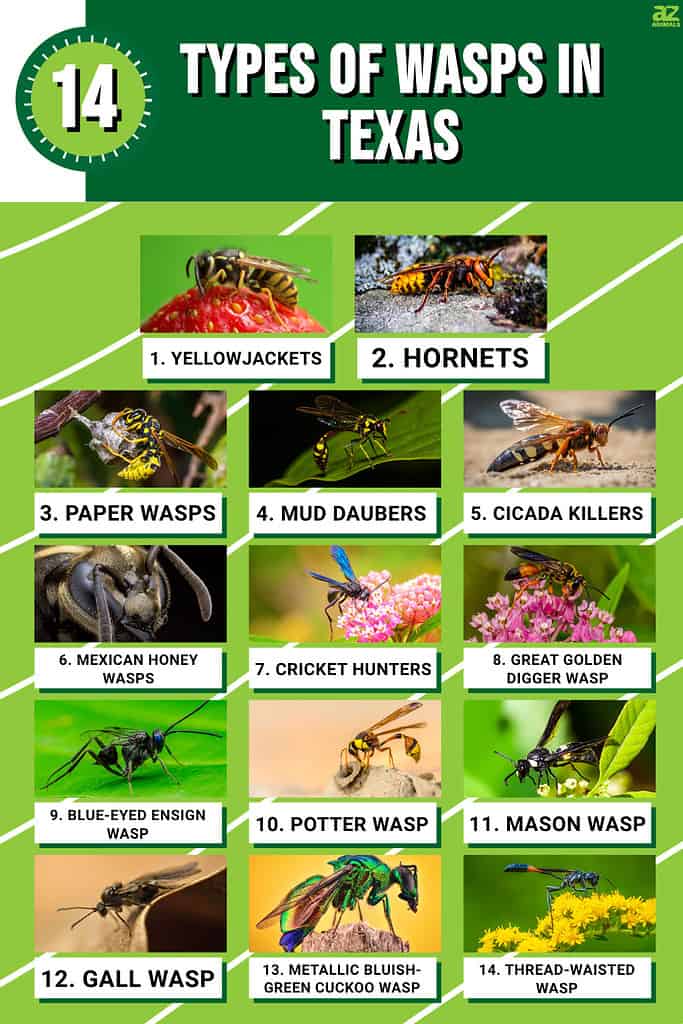
14 Types of Wasps in Texas
1. Yellowjackets

Yellowjackets help with pollination.
©Henrik Larsson/Shutterstock.com
Yellowjackets are a gregarious species that are aggressive and can be found in North Texas. This stinging bug will go to great lengths to defend its residence. Although honey bees and paper wasps are frequently confused with yellowjackets, some traits set the three apart. Yellowjackets help with pollination. However, they are less efficient than honey bees or bumble bees because they lack fluffiness.
Since they feed on insects instead of flowers, yellowjackets are a blessing for gardeners. In addition to their main diet of sugars and carbs, adult yellowjackets will also consume insects, meat, and fish. They won’t bother people unless they feel threatened like most wasps in Texas do. However, they may deliver many stings and turn aggressive when confronted.
2. Hornets
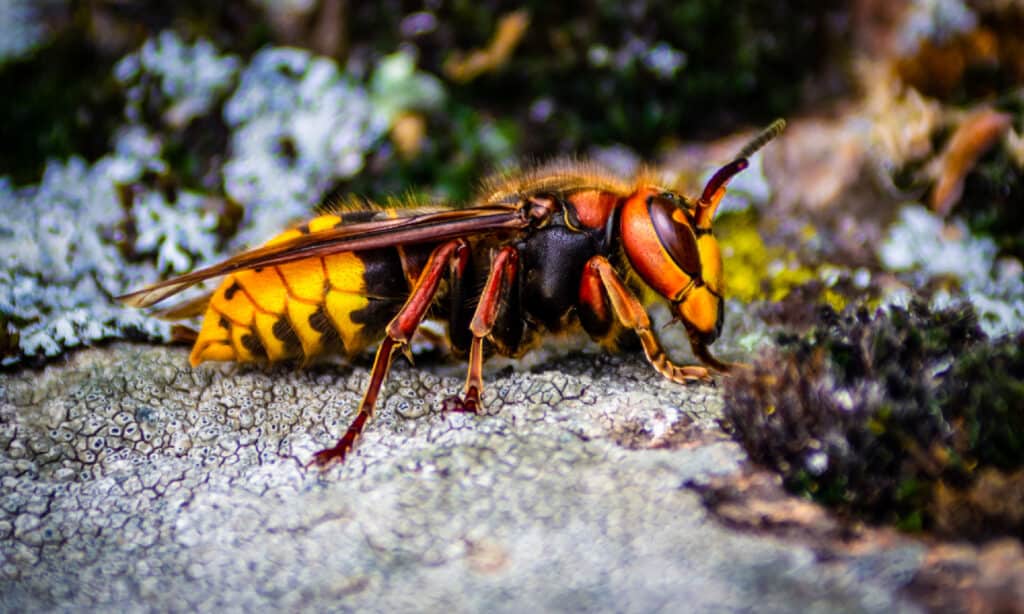
There are 22 species of hornets.
©Elina Litovkina/Shutterstock.com
The hornet is a versatile and strong insect frequently feared and despised. They are one of the most aggressive and largest wasp species, with large, primarily black bodies and light yellow patterns on their faces. These pests are frequently mistaken for their relative, the Texas yellowjacket. Although this stinging bug appears dangerous, it benefits our ecosystems in many ways. It also consumes a range of plants and animals. There are 22 species of hornets. The European hornet, which will consume bees but poses little harm to the hive, is the most prevalent hornet in North America and Europe.
3. Paper Wasps

The paper wasp is the most prevalent wasp species in Texas.
©JorgeOrtiz_1976/Shutterstock.com
The most prevalent species of wasp found in or near Texas dwellings is the paper wasp. It is characterized by six long, thin legs that “dangle” below the body as it flies. Paper wasps resemble yellowjackets due to their black or brown bodies with yellow and orange markings. Wasps like yellowjackets and paper wasps are very similar, making it challenging for the typical individual to distinguish between them. As paper wasps dangle their legs, the fastest way to differentiate the two is to check if the insect’s legs are visible.
4. Mud Daubers
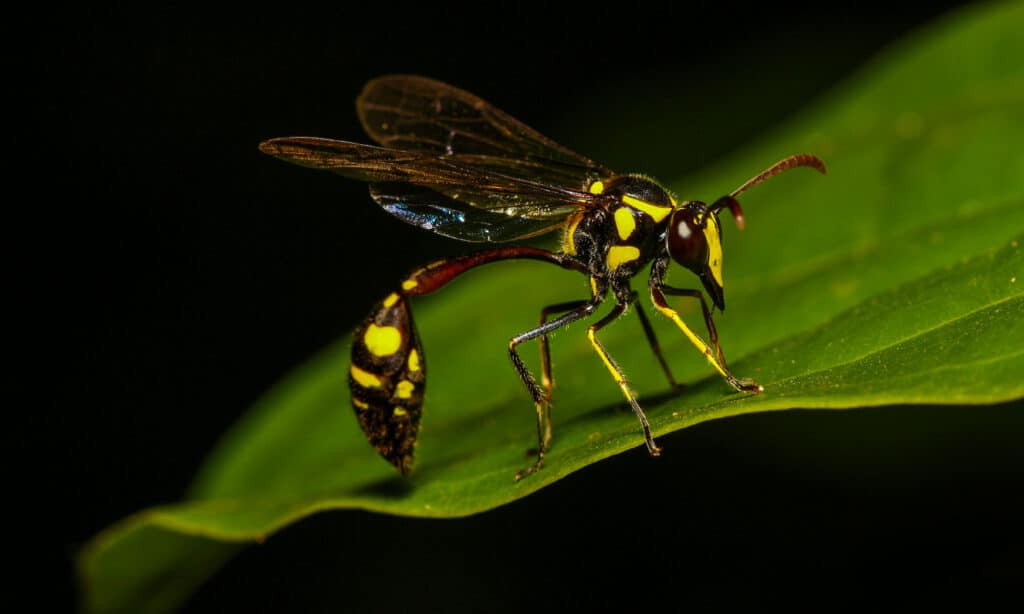
Due to the number of spiders they eliminate, daubers serve as a natural pest management system.
©Preecha Ngamsrisan/Shutterstock.com
These solitary wasps are significantly more slender than other wasp species in Northern Texas and can grow up to 1 inch in length, and they have a thin waist between their thorax and abdomen. The less aggressive mud daubers won’t attack unless they are repeatedly provoked. Most dauber species are adept spider hunters and can kill as many as 25 to 30 spiders in each nested tube. Due to the number of spiders they eliminate, daubers serve as a natural pest management system. Crab spiders, orb weavers, jumping spiders, and brown and black widows are typically the targets. Thus, destroying or removing daubers is often not a good idea.
5. Cicada Killers

The cicada killer is a huge, lone species of digger wasp, also known as the cicada hawk.
©samray/Shutterstock.com
These are some of the biggest wasp species in North Texas, frequently growing to lengths of 0.6 to 2.0 inches. They feature an abdomen with black and yellow stripes and a dark red head. The cicada killer is a huge, lone species of digger wasp, also known as the cicada hawk. Despite not being a member of the hornet family, this insect occasionally goes by the name eastern cicada killer or sand hornet. The eastern and central United States, Mexico, and Central America are all home to cicadas killers. The females seek cicadas, which they feed their larvae, giving them their name.
6. Mexican Honey Wasps
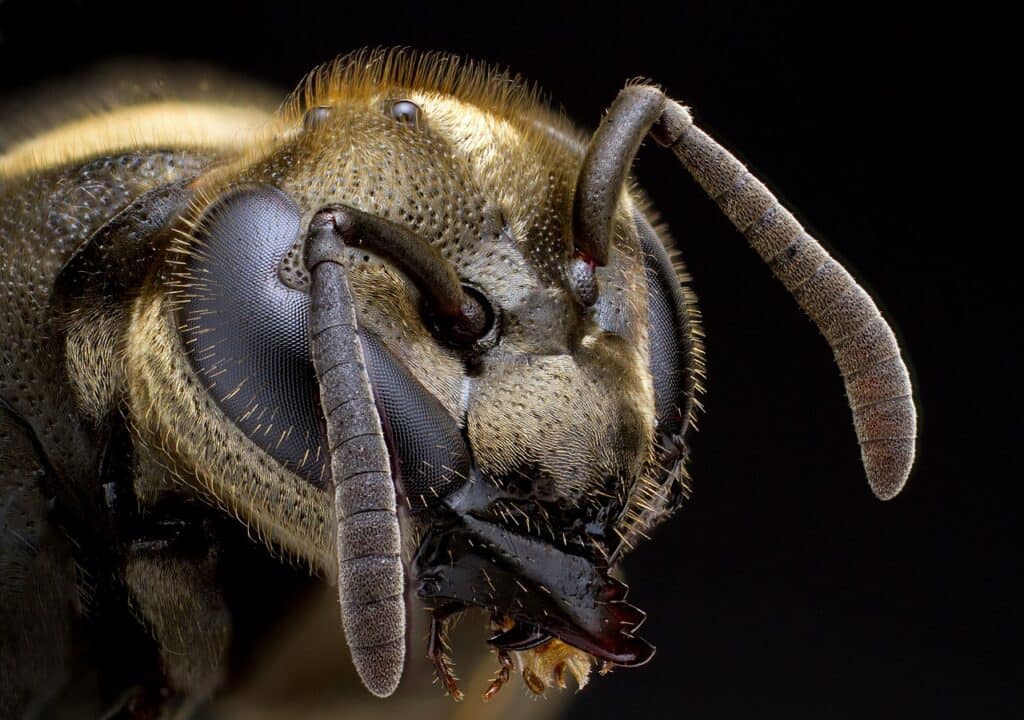
Mexican honey wasps build paper nests typically found in bushes and trees.
©Alex Wild/Insects Unlocked / CC0 1.0 – License
Although this wasp species is endemic to Mexico, it occasionally travels to Texas. It is one of the few wasp species that produce honey, making it a useful species. Mexican honey wasps build paper nests typically found in bushes and trees. They are less hairy than a honey bee, almost entirely black, and smaller. They also tend to disregard human activity and are not particularly hostile. By transporting pollen on its abdomen, the wasp aids in pollinating avocado fields. Due to the lack of tiny hair follicles on their lower bodies, most other wasps cannot perform this.
7. Cricket Hunters
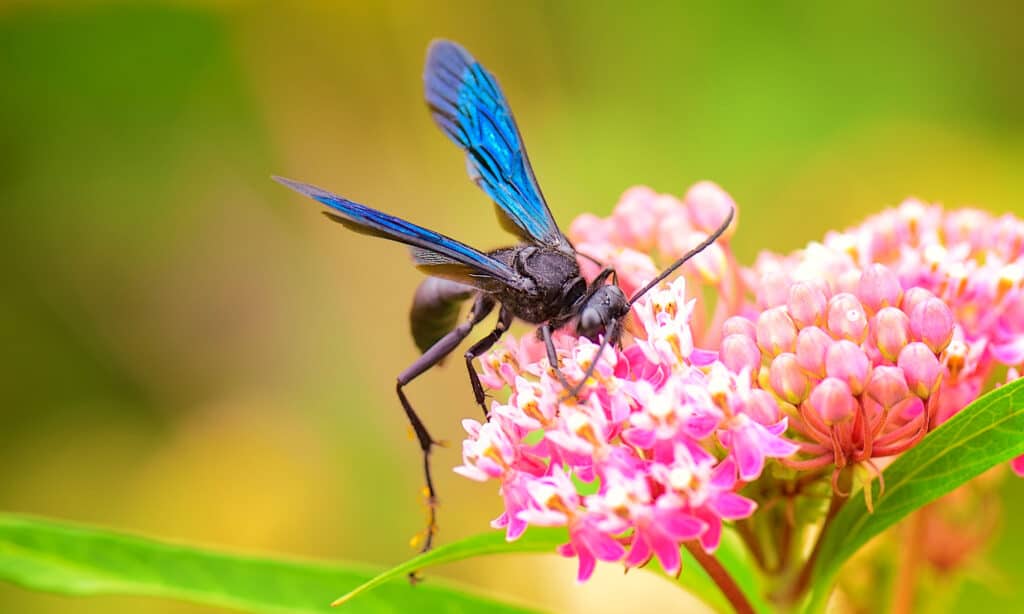
Cricket hunters can enter a house through cracks in the foundation.
©iStock.com/Joesboy
Although not prevalent in North Texas, these solitary wasps can enter a house through cracks in the foundation. They grab and paralyze live crickets; females then lay a single egg on a cricket prey. After hatching, the larvae immediately start consuming the prey. Cricket hunters create their nests in empty spaces and enter buildings through tiny fissures or gaps. If they appear within, they can be a sign of a worse issue. Furthermore, they will sting people if they are provoked.
8. Great Golden Digger Wasp
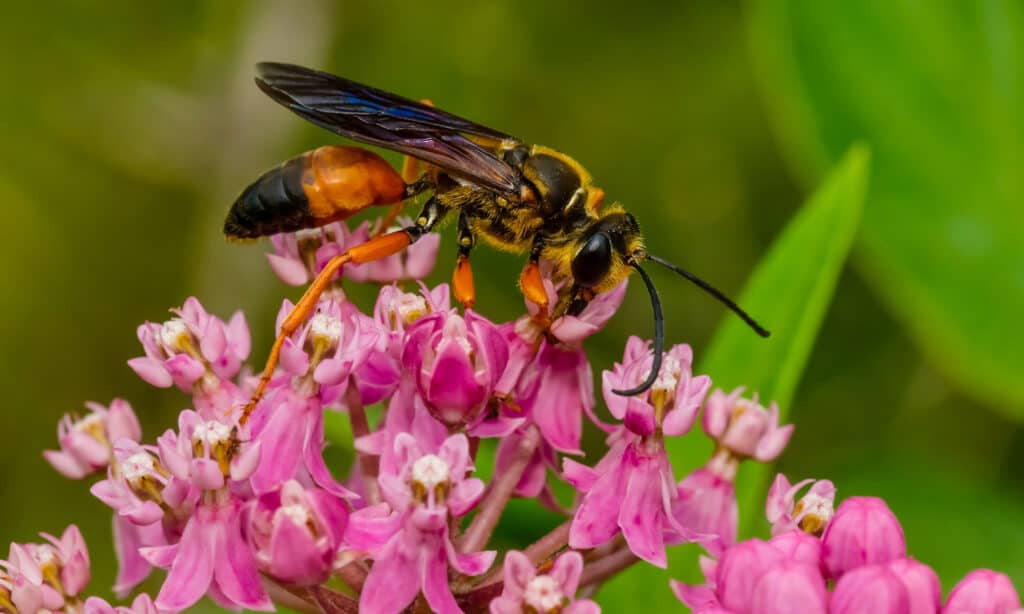
The digger wasp protects its eggs from predators by burying its eggs in the ground.
©Paul Reeves Photography/Shutterstock.com
The digger wasp is remarkable. To protect the eggs from outside predators, it buries its eggs in the ground and covers them. The Galveston/Houston area is frequently home to these wasps, although they are not frequently seen due to their wariness. This species’ ability to successfully avoid female wasp attacks and avoid attacks by birds like robins interested in their food is essential to its survival.
9. Blue-Eyed Ensign Wasp
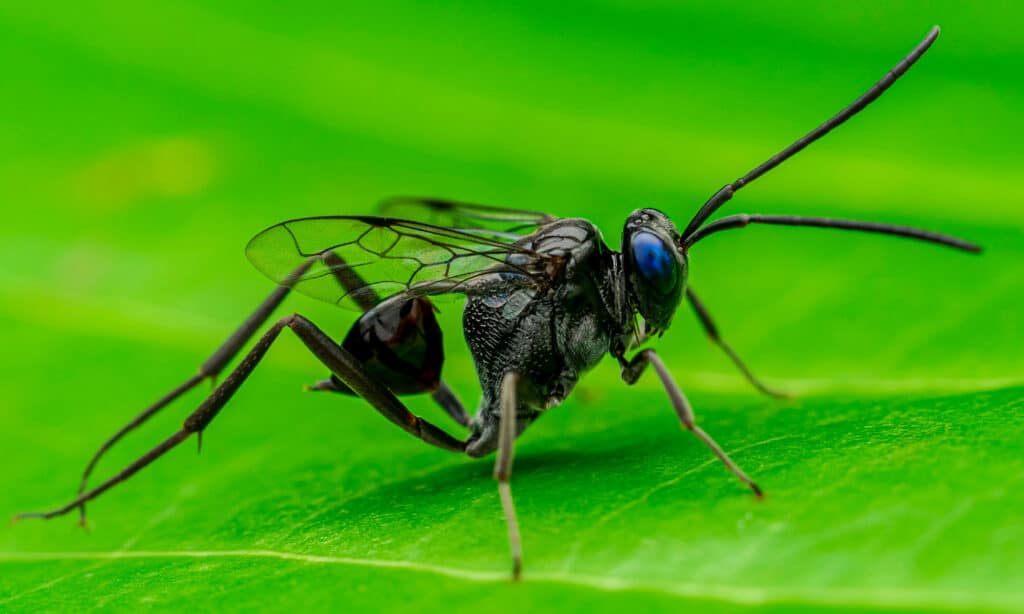
The blue-eyed ensign wasp helps to control the cockroach population.
©fendercapture/Shutterstock.com
The huge blue eyes of the blue-eyed ensign wasp give it its name. Although its origins are uncertain, most experts believe it came from Asia and into Texas and the United States. Today, it can be found in many temperate areas and the tropics and subtropics. The species is well known for helping to control cockroach populations. For every egg the wasp lays, one cockroach must be killed. The larvae need enough food to grow fully, so the eggs are deposited on cockroaches.
10. Potter Wasp

Potter wasps have black bodies with yellow patterns on the thorax and abdomen.
©MRS. NUCH SRIBUANOY/Shutterstock.com
The potter wasp normally grows to a maximum size of 20mm and has a long, slender body. When at rest, potter wasp wings are folded in half lengthwise. They have a thin “waist” and black bodies with yellow patterns on the thorax and abdomen. Their distinctive way of mating, which entails building tiny mud structures that look like pots to lay eggs in, makes them easily identifiable. As a feeding supply for larvae, mud pots must be big enough to hold both an egg and a live caterpillar.
11. Mason Wasp

Mason wasps have white to slightly yellowish patches on their faces.
©Wilfreda Wiseman/Shutterstock.com
All around the Galveston-Houston region, red and black mason wasps can be found. Male red and black mason wasps have a pentagonal (five-sided), white to slightly yellowish patch on their faces. The same region of the head is reddish in females. Humans can be stung by wasps of both sexes. Even though it doesn’t happen often, the sting hurts and is frequently compared to the pain from a bald-faced hornet sting.
12. Gall Wasp

Most galls, particularly those on leaves, don’t harm oak trees or people, and neither do the wasps.
©D. Kucharski K. Kucharska/Shutterstock.com
In Texas, gall wasps are among the smallest wasps. This unique species is only a few millimeters long (about 6 to 8mm) and is occasionally difficult to spot. They reside in homes that resemble wool, as suggested by their name. These are typical in areas with oak trees and oak woodlands. Each of these galls is brought on by a tiny wasp whose life cycle is convoluted and little understood.
Most galls, particularly those on leaves, don’t harm oak trees or people, and neither do the wasps. Like many other insects, the wasps that live inside these galls are a valuable source of food for our natural animals, including many different bird species and mammals like opossums and raccoons.
13. Metallic Bluish-Green Cuckoo Wasp
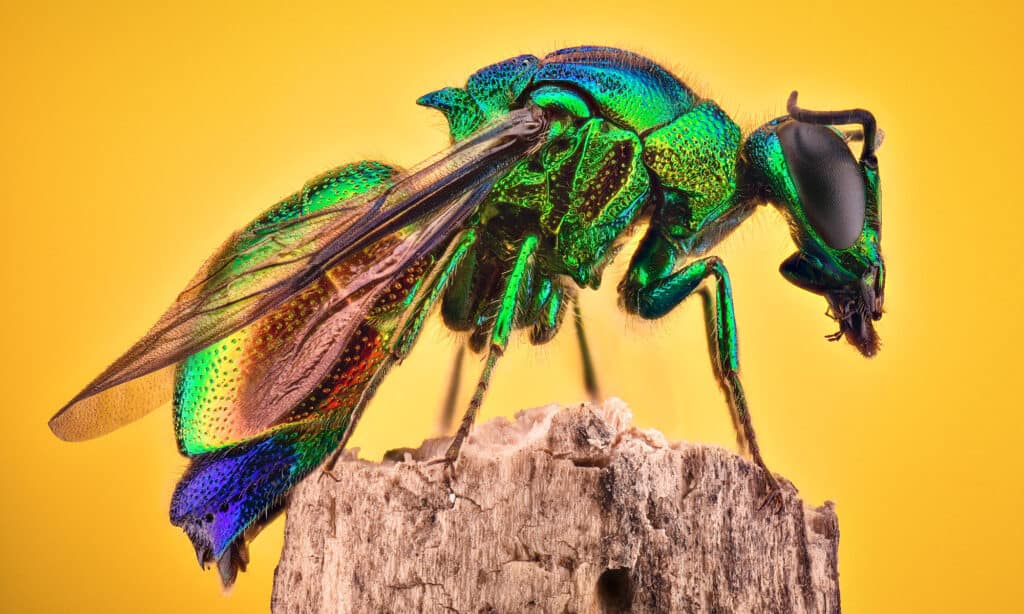
The metallic bluish-green cuckoo wasp is an invasive species.
©Cornel Constantin/Shutterstock.com
Perhaps one of the most beautifully-colored wasps on Earth, this beautiful wasp is a parasitic killer. A parasitic wasp species in Texas and a few other parts of the United States is called the metallic bluish-green cuckoo wasp. You don’t want to come into contact with one of these despite being among the most stunning insects we’ve ever seen. Since it is thought to have arrived in North America with World War II ships, it is not a native of the continent.
14. Thread-waisted Wasp

Thread-waisted wasps feed parasitically on other insects and spiders.
©samray/Shutterstock.com
The thread-waisted wasp lives in habitats with soft soil and sand. Usually longer than 2.5 cm (approximately 1 inch), thread-waisted wasps feed parasitically on other insects and spiders. Because they consume pests like grasshoppers and caterpillars, they can be regarded as beneficial insects depending on the species.
The photo featured at the top of this post is © Cornel Constantin/Shutterstock.com
Thank you for reading! Have some feedback for us? Contact the AZ Animals editorial team.





